Experimental Investigation into Waterproofing Performance of Cement Mortar Incorporating Nano Silicon
Abstract
1. Introduction
2. Materials and Methods
2.1. Materials
2.2. Characterization of Nano Silicon
2.2.1. Energy Dispersive X-Ray Spectroscopy
2.2.2. Field Emission Scanning Electron Microscope
2.2.3. X-Ray Diffraction
2.2.4. Image-J Software
2.2.5. Surface Charge (Zeta Potential)
2.2.6. Fourier Transform Infrared Spectroscopy (FTIR)
2.3. Experimental Planning for Modeling and Optimization of the Mix Ratio
2.4. Preparation of Mix
2.4.1. Consistency Test
2.4.2. Capillary Water Absorption
2.4.3. Volume of Water Permeable Voids
2.4.4. Gas Permeability
3. Results and Discussion
3.1. Results
3.1.1. Energy Dispersive X-Ray Spectroscopy
3.1.2. Particle Morphology of Nano Silicon
3.1.3. X-Ray Diffraction
3.1.4. Particle Size Distribution of Nano Silicon
3.1.5. Surface Charge (Zeta Potential) of Nano Silicon
3.1.6. Fourier Transform Infrared Spectroscopy
3.1.7. Modeling and Optimization Experimental Variables (Nano Silicon, w/c Ratio and Capillary Water Absorption)
3.1.8. Model Summary
3.1.9. Analysis of Variance (ANOVA)
- Where A is the nano silicon dose;
3.1.10. Model Evaluation
3.1.11. Three-Dimensional Response Surface Plot in the Optimization of Nano Silicon and w/c
3.1.12. Desirability Plot
3.1.13. Consistency Test Result
3.1.14. Capillary Water Absorption of Mortar Incorporating Nano Silicon and OPC Mortar
3.1.15. Volume of Water Permeable Voids
3.1.16. Gas Permeability
3.1.17. FESEM Micrograph
3.1.18. X-Ray Diffraction Result
4. Conclusions
5. Theoretical Implication
6. Practical Implication
7. Future Works
8. Potential End Users
Author Contributions
Funding
Data Availability Statement
Acknowledgments
Conflicts of Interest
References
- De Schutter, G.; Audenaert, K. Evaluation of Water Absorption of Concrete as a Measure for Resistance Against Carbonation and Chloride Migration. Mater. Struct. 2004, 37, 591–596. [Google Scholar] [CrossRef]
- Liu, J.; Vipulanandan, C. Evaluating a Polymer Concrete Coating for Protecting Non-Metallic Underground Facilities from Sulfuric Acid Attack. Tunn. Undergr. Space Technol. 2001, 16, 311–321. [Google Scholar] [CrossRef]
- Chen, J.; Ummin, O.; Yu, T.; Qi, Y. Applications of Rayleigh Wave Detection Technique and Polymer Grouting Technology in Waterproof Construction. Appl. Mech. Mater. 2013, 405-408, 748–754. [Google Scholar] [CrossRef]
- Kenai, S.; Bahar, R. Evaluation and Repair of Algiers New Airport Building. Cem. Concr. Compos. 2003, 25, 633–641. [Google Scholar] [CrossRef]
- Lin, J.; Scott, D. Assessment of Significances of Building Failure Induced by Foundation Failure. In Building Integration Solutions, Proceedings of the Architectural Engineering Conference, Omaha Nebraska, NE, USA, 29 March–1 April 2006; American Society of Civil Engineers: Reston, VA, USA, 2006; pp. 1–13. [Google Scholar]
- Jumaat, M.Z.; Kabir, M.H.; Obaydullah, M. A Review of the Repair of Reinforced Concrte Beams. J. Appl. Sci. Res. 2006, 2, 317–326. [Google Scholar]
- Bhaskaran, R.; Palaniswamy, N.; Rengaswamy, N.S. A Review of Differing Approaches Used to Estimate the Cost of Corrosion (and Their Relevance in the Development of Modern Corrosion Prevention and Control Strategies). Anti-Corros. Methods Mater. 2013, 52, 29–41. [Google Scholar] [CrossRef]
- Naville, A. Properties of Concrete-Fourth and Final Edition; Pearson Education Limited: Essex, UK, 2002. [Google Scholar]
- Dai, J.; Akira, Y.; Wittmann, F.H.; Yokota, H.; Zhang, P. Water Repellent Surface Impregnation for Extension of Service Life of Reinforced Concrete Structures in Marine Environments: The Role of Cracks. Cem. Concr. Compos. 2010, 32, 101–109. [Google Scholar] [CrossRef]
- Zhu, Y.-G.; Kou, S.-C.; Poon, C.-S.; Dai, J.-G.; Li, Q.-Y. Influence of silane-based water repellent on the durability properties of recycled aggregate concrete. Cem. Concr. Compos. 2013, 35, 32–38. [Google Scholar] [CrossRef]
- National Cooperative Highway Research Program (NCHRP 244). Concrete Sealers and Protection of Bridge Structures; Transport Research Board: Washington, DC, USA; National Research Council: Ottawa, ON, Canada, 1981.
- German Committee of Reinforced Concrete (DAfStb). Guidelines for the Protection and Repair of Concrete Components. Part 3: Quality Assurance in Execution of the Works; Beuth Verlag GmbH: Berlin, Germany, 1991. [Google Scholar]
- Basheer, P.A.M.; Cleland, D.J.; Long, A.E. Surface Treatment for Concretes: Assessment Methods and Reported Performance. Constr. Build. Mater. 1997, 11, 413–429. [Google Scholar] [CrossRef]
- EN 14695:2010; Flexible Sheets for Waterproofing—Reinforced Bitumen Sheets for Waterproofing of Concrete Bridge Decks and Other Trafficked Areas of Concrete-Definitions and Characteristics. British Standards Institutition: London, UK, 2010.
- Muhammad, N.Z.; Keyvanfar, A.; Majid, M.Z.A.; Mirza, J.; Shafaghat, A. Waterproof Performance of Concrete: A Critical Review on Implemented Approaches. Constr. Build. Mater. 2015, 101, 80–90. [Google Scholar] [CrossRef]
- Zhou, Q.; Xu, Q. Experimental study of waterproof membranes on concrete deck: Interface adhesion under influences of critical factors. Mater. Des. 2009, 30, 1161–1168. [Google Scholar] [CrossRef]
- Liu, Y.; Wu, J.; Chen, J. Mechanical Properties of a Waterproofing Adhesive Layer Used on Concrete Bridges Under Heavy Traffic and Temperature Loading. Int. J. Adhes. Adhes. 2014, 48, 102–109. [Google Scholar] [CrossRef]
- Blight, G.E. A Study of Four Waterproofing Systems for Concrete. Mag. Concr. Res. 1991, 43, 197–203. [Google Scholar] [CrossRef]
- Suffian, A. Some Common Maintenance Problems and Building Defects: Our Experiences. Procedia Eng. 2013, 54, 101–108. [Google Scholar] [CrossRef]
- Pedrossa, A.; Del Rio, M. Synthetic Waterproofing Membranes and Auxiliary Separating Layers in The Inverted Flat Roof. Pressure Effect on The Degradation. Mater. De Constr. 2018, 68, e167. [Google Scholar] [CrossRef]
- Zhang, P.; Zhao, T.; Wittmann, F.H.; Li, S. Preparation and Characteristics of Integral Water Repellent Cement-Based Materials. Mater. Sci. Forum 2011, 675–677, 1189–1192. [Google Scholar] [CrossRef]
- Apay, A.C.; Ozgan, E.; Turgey, T.; Akyol, K. Investigation and Modeling the Effects of Waterproofing and Water Repellent Admixtures Dosages on the Permeability and Compressive strength of Concrete. Constr. Build. Mater. 2016, 13, 698–711. [Google Scholar] [CrossRef]
- Victoria, E.G.; Antonio, J.T.; Jose, M.S.; Marcos, L. Influence of Crystalline Admixtures on the Short-Term Behaviour of Mortars Exposed to Sulphuric Acid. Materials 2019, 12, 82. [Google Scholar]
- Ji, T. Preliminary Study on the Water Permeability and Microstructure of Concrete Incorporating Nano-SiO2. Cem. Concr. Res. 2005, 35, 1943–1947. [Google Scholar] [CrossRef]
- Florence, S.; Konstantin, S. Nanotechnology in Concrete—A Review. Constr. Build. Mater. 2010, 24, 2060–2071. [Google Scholar]
- Teizer, J.; Venugopal, M.; Teizer, W.; Felkl, J. Nanotechnology and Its Impact on Construction: Bridging the Gap Between Researchers and Industry Professionals. J. Constr. Eng. Manag. 2012, 138, 594–604. [Google Scholar] [CrossRef]
- Firoozi, A.A.; Taha, M.R.; Firoozi, A.A. Nanotechnology in Civil Engineering. Eloctronic J. Geotech. Eng. 2014, 19, 4673–4682. [Google Scholar]
- Woo, R.S.C.; Zhu, H.; Chow, M.M.K.; Leung, C.K.Y.; Kim, J. Science and Barrier performance of silane—Clay nanocomposite coatings on concrete structure. Compos. Sci. Technol. 2008, 68, 2828–2836. [Google Scholar] [CrossRef]
- Zhang, Z.; MacMullen, J.; Dhakal, H.N.; Radulovic, J.; Herodotou, C.; Totomis, M.; Bennett, N. Enhanced Water Repellence and Thermal Insulation of Masonry by Zinc Oxide Treatment. Energy Build. 2012, 54, 40–46. [Google Scholar] [CrossRef]
- Hou, P.; Cheng, X.; Qian, J.; Shah, S.P. Effects and Mechanisms of Surface Treatment of Hardened Cement-Based Materials with Colloidal nanoSiO2 and Its Precursor. Constr. Build. Mater. 2014, 53, 66–73. [Google Scholar] [CrossRef]
- Hou, P.; Cheng, X.; Qian, J.; Zhang, R.; Cao, W.; Shah, S.P. Characteristics of Surface-Treatment of Nano-SiO2 on the Transport Properties of Hardened Cement Pastes with Different Water-to-Cement Ratios. Cem. Concr. Compos. 2015, 55, 26–33. [Google Scholar] [CrossRef]
- Hallmann, S.; Fink, M.J.; Mitchell, B.S. Wetting Properties of Silicon films from Alkyl-Passivated Particles Produced by Mechanochemical Synthesis. J. Colloid. Interface Sci. 2010, 348, 634–641. [Google Scholar] [CrossRef] [PubMed]
- Vejmelková, E.; Konakova, D.; Cachova, M.; Kippert, M.; Cerny, R. Effect of Hydrophobization on the Properties of Lime–metakaolin Plasters. Constr. Build. Mater. 2012, 37, 556–561. [Google Scholar] [CrossRef]
- Nunes, C.; Slížková, Z. Hydrophobic Lime Based Mortars with Linseed Oil: Characterization and Durability Assessment. Cem. Concr. Res. 2014, 61–62, 28–39. [Google Scholar] [CrossRef]
- Novak, V.; Zach, J. The Effect of Hydrophobization on the Properties of Mortar MixturesIOP Conference Series. Mater. Sci. Eng. 2018, 385, 012040. [Google Scholar] [CrossRef]
- Shidar, M.R.; Golshan, A.; Izman, S.; Ghodsiyeh, D. The Application of Surface Response Methodology to the Pretreatment of WC Substrates Prior to Diamond Coating. J. Mater. Eng. Perform. 2013, 23, 13–24. [Google Scholar] [CrossRef]
- Shidar, M.R.; Izman, S.; Taheri, N.M.; Assadian, M.; AbdulKadir, M.R. Effect of Post-Treatment Techniques on Corrosion and Wettability of Hydroxyapatite CoatedCo-Cr-Mo Alloy. Arab. J. Sci. Eng. 2015, 40, 1197–1203. [Google Scholar] [CrossRef]
- Kabo, K.S.; Yacob, A.R.; Bakar, W.A.W.A.; Buang, N.A.; Bello, A.M.; Ruskam, A. BBD Optimization of K-ZnO Catalyst Modification Process for Heterogeneous Transesterification of Rice Bran Oil to Biodiesel. IOP Conf. Ser. Mater. Sci. Eng. 2015, 136, 012063. [Google Scholar] [CrossRef]
- Assadian, M.; Shidar, M.R.; Idris, M.H.; Izman, S.; Almosi, D.; Taheri, M.M.; Abdulkadir, M.R. Optimization of Electrophoretic Deposition Parameters in Coating Metallic Substarte by Hydroxyapatite Using Response Surface Metjhodology. Arab. J. Sci. Eng. 2015, 40, 923–933. [Google Scholar] [CrossRef]
- ASTMC150; Standard Specification for Portland Cement. American Society for Testing and Materials: West Conshohocken, PA, USA, 2012.
- ASTMC33; Standard Specification for Concrete Aggregates. American Society for Testing and Materials: West Conshohocken, PA, USA, 2013.
- Marimune, S.; Kotera, M.; Nishino, T.; Goto, K.; Hata, K. Poly(vinyl alcohol) Nanocomposites with Nanodiamond. Macromolecules 2011, 44, 4415–4421. [Google Scholar] [CrossRef]
- Bothun, G.D. Hydrophobic Silver nanoparticles Trapped in Lipid Bilayers: Size Distribution, Bilayer Phase Behavior, and Optical Properties. J. Nanobiotechnol. 2008, 6, 13. [Google Scholar] [CrossRef] [PubMed]
- Mazzol, A.; Favoni, O. Particle Size, Size Distribution and Morphological Evaluation of Airbone dust Particles of Diverse Woods by Scanning Electron Microscopy and Image Processing Program. Powder Technol. 2012, 225, 65–77. [Google Scholar] [CrossRef]
- Jiang, J.; Oberdörster, G.; Biswas, P. Characterization of Size, Surface Charge, and Agglomeration State of Nanoparticle Dispersions for Toxicological Studies. J. Nanoparticle Res. 2009, 11, 77–89. [Google Scholar] [CrossRef]
- Hallmann, S.; Fink, M.J.; Mitchell, B.S. Mechanochemical Synthesis of Functionalized Silicon Nanoparticles with Terminal Chlorine Groups. J. Mater. Res. 2011, 26, 1052–1060. [Google Scholar] [CrossRef]
- Bas, D.; Boyach, I.S. Modeling and Optimization I: Usability of Response Surface Methodology. J. Food Eng. 2007, 78, 836–845. [Google Scholar] [CrossRef]
- Ferreira, S.L.C.; Bruns, R.E.; Silve, E.G.; Pa Santos, W.N.; Quintella, C.M.; David, J.M.; Andrade, J.; Breitkreitz, M.C.; Jardim, I.C.S.F.; Neto, B.B. Statistical Designs and Response Surface techniques for the Optimization of Chromatographic System. J. Chromatogr. A 2007, 1158, 2–14. [Google Scholar] [CrossRef] [PubMed]
- Bezerra, M.A.; Santelli, R.E.; Oliveira, E.P.; Villar, L.S.; Escaleira, L.A. Response Surface Methodology (RSM) as a Tool for Optimization in Analytical Chemistry. Talanta 2008, 76, 965–977. [Google Scholar] [CrossRef] [PubMed]
- Muhammad, N.Z.; Keyvanfa, A.; Shafaghat, A.; Majid, M.Z.; Mirza, J.; Mccaffer, R.; Aliyu, M.M. Optimization of Nano Silicon for Integral Mixing in Cement Mortar: A Response Surface Methodology Approach. AIP Conf. Proc. 2020, 2284, 020009. [Google Scholar] [CrossRef]
- ASTMC109; Standard Test Methods for rate for Compressive Strength of Hydraulic Cement Mortars. American Society for Testing and Materials: West Conshohocken, PA, USA, 2012.
- ASTMC305; Standard Practice for Mechanical Mixing of Hydraulic Cement Pastes and Mortars of Plastic Consistency. American Society for Testing and Materials: West Conshohocken, PA, USA, 2014.
- ASTMC1437; Standard Test Methods for Flow of Hydraulic Cement Mortar. American Society for Testing and Materials: West Conshohocken, PA, USA, 2013.
- ASTMC1403C; Standard Test Methods for rate of Water Absorption for Masonry Mortars. American Society for Testing and Materials: West Conshohocken, PA, USA, 2013.
- ASTMC642; Standard Test Method for Density, Absorption, and Voids in Hardened Concrete. American Society for Testing and Materials: West Conshohocken, PA, USA, 2006.
- International Union of Testing and Research Laboratories for Materials and Structures. Penetration and Permeability of Concrete: Barrier to Organic Contaminating Liquids; RILEM Report; CRC Press: Boca Raton, FL, USA, 1997; p. 146. [Google Scholar]
- Alshamsi, A.M.; Imran, H.D.A. Development of a Permeability Apparatus for Concrete and Mortar. Cem. Concr. Res. 2002, 32, 923–929. [Google Scholar] [CrossRef]
- Karlina, A.I.; Karlina, Y.I.; Gladkikh, V.A. Analysis of Experience in the use of Micro-and nano Additives from Silicon Production Waste in Concrete Technologies. Minerals 2023, 13, 1525. [Google Scholar] [CrossRef]
- Han, B.; Yang, Z.; Shi, X.; Yu, X. Transport Properties of Carbon-Nanotube/Cement Composites. J. Mater. Eng. Perform. 2012, 22, 184–189. [Google Scholar] [CrossRef]
- Wang, H.; Xu, Z.; Fink, M.J.; Mitchell, B.S. Functionalized silicon nanoparticles from reactive cavitation erosion of silicon wafers. Chem. Commun. 2014, 51, 1465–1468. [Google Scholar] [CrossRef]
- Plank, J.; Hirsch, C. Impact of Zeta Potential of Early Cement Hydration Phases on Superplasticizer Adsorption. Cem. Concr. Res. 2007, 37, 537–542. [Google Scholar] [CrossRef]
- Rajagopalan, T.; Wang, X.; Lahlouh, B.; Ramkumar, C.; Dutta, P.; Gangopadhyay, S. Low Temperature Deposition of Nano Crystalline Silicon Carbide Films by Plasma Enhanced Chemical Vapor Deposition and Their Structural and Optical Characterization. J. Appl. Phys. 2003, 94, 5252–5260. [Google Scholar] [CrossRef]
- Ventolà, L.; Vendrell, M.; Giraldez, P.; Merino, L. Traditional Organic Additives Improve Lime Mortars: New Old Materials for Restoration and Building Natural Stone Fabrics. Constr. Build. Mater. 2011, 25, 3313–3318. [Google Scholar] [CrossRef]
- Klisińska-Kopacz, A.; Tišlova, R. Effect of Hydrophobization Treatment on the Hydration of Repair Roman Cement Mortars. Constr. Build. Mater. 2012, 35, 735–740. [Google Scholar] [CrossRef]
- Falchi, L.; Müller, U.; Fontana, P.; Izzo, F.C.; Zendri, E. Influence and Effectiveness of Water-Repellent Admixtures on Pozzolana–lime Mortars for Restoration Application. Constr. Build. Mater. 2013, 49, 272–280. [Google Scholar] [CrossRef]
- Kahir, U.; Fahmi, H.; Hakim, S.A.; Rohim, R. Forecasting Error Calculation with Mean Absolute Deviation and Mean Absolute Percentage Error. J. Phys. Conf. Ser. 2017, 930, 012002. [Google Scholar] [CrossRef]
- Liu, X.; Li, C.; Niu, Z.; Pang, Y.; Chen, M. Durability of cement mortar under sulphate partial immersion based on a novel hydrophobic agent. Case Stud. Constr. Mater. 2025, 22, 4575. [Google Scholar] [CrossRef]
- Sun, J.; Shi, C.; Li, P.; Li, A. Influence of Nanomodified Waterproofing Agent on the Performance of Rigid Waterproof Concrete in Underground Engineering. J. Nanomater. 2022, 2022, 2966551. [Google Scholar] [CrossRef]
- Liu, P.; Liu, M.; Sha, F.; Chen, Y.; Zhi, W.; He, S.; Yu, Z. Preparation and performance investigation of a high efficiency cement permeation type waterproofing materials. Constr. Build. Mater. 2023, 364, 130140. [Google Scholar] [CrossRef]
- Ayyoob, S.; Zaki, M.; Khan, M.S.; Khan, S.A.; Kamal, M.A. The Efficiency of Waterproofing Agents in Concrete: Assessment of Compressive Strength and Permeability. Am. J. Civ. Eng. Arch. 2022, 10, 137–146. [Google Scholar] [CrossRef]
- Cai, J.; Ran, Q.; Ma, Q.; Zhang, H.; Liu, K.; Zhou, Y.; Mu, S. Influence of a Nano-Hydrophobic Admixture on Concrete Durability and Steel Corrosion. Materials 2022, 5, 6842. [Google Scholar] [CrossRef]
- Du, H.; Du, S.; Liu, X. Effect of nano-silica on the mechanical and transport properties of lightweight concrete. Constr. Build. Mater. 2025, 82, 114–122. [Google Scholar] [CrossRef]
- Tittaralle F and Moriconi, G. The effect of silane-based hydrophobic admixture on corrosion of reinforcing steel in concrete. Cem. Concr. Res. 2008, 38, 1354–1357. [Google Scholar] [CrossRef]

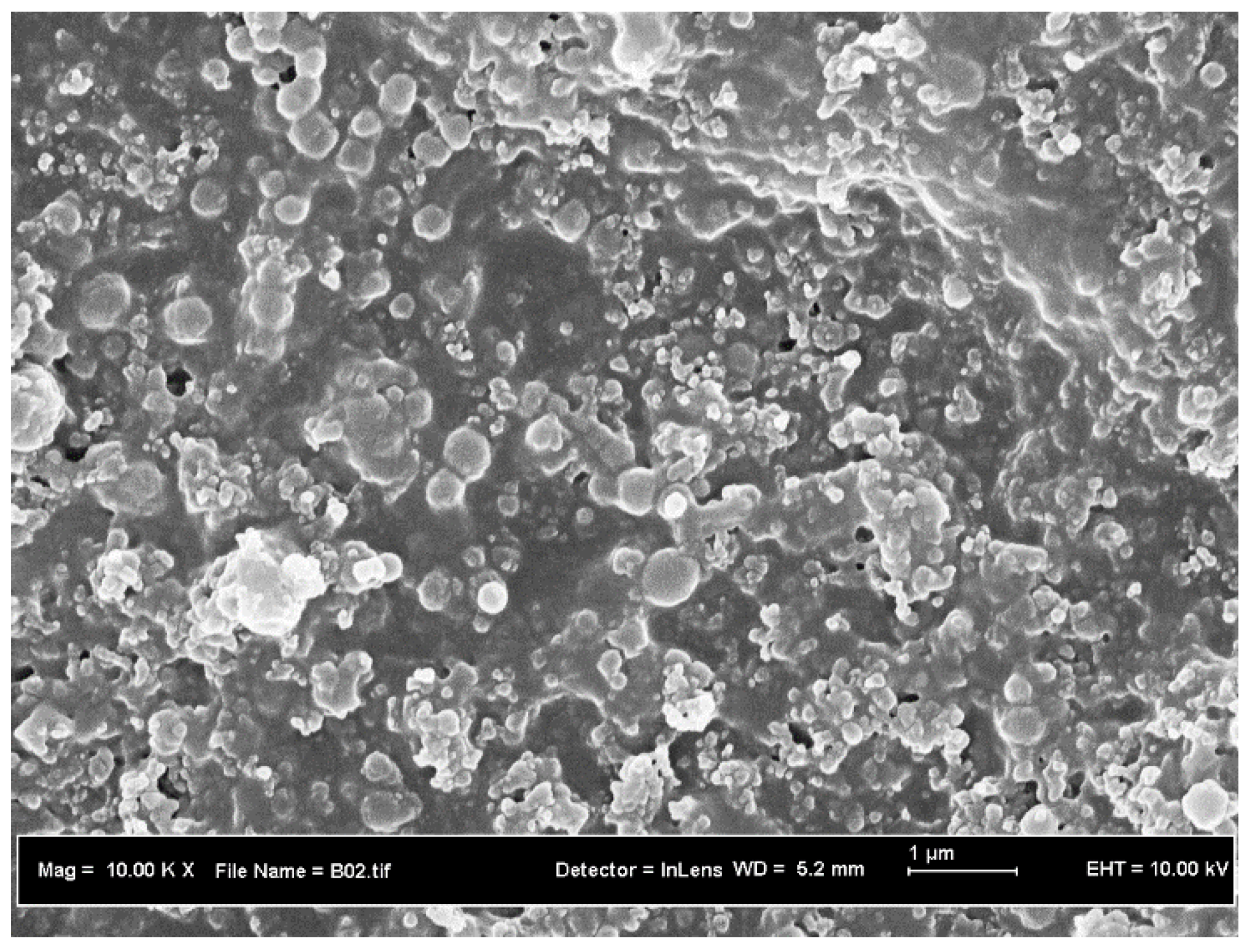
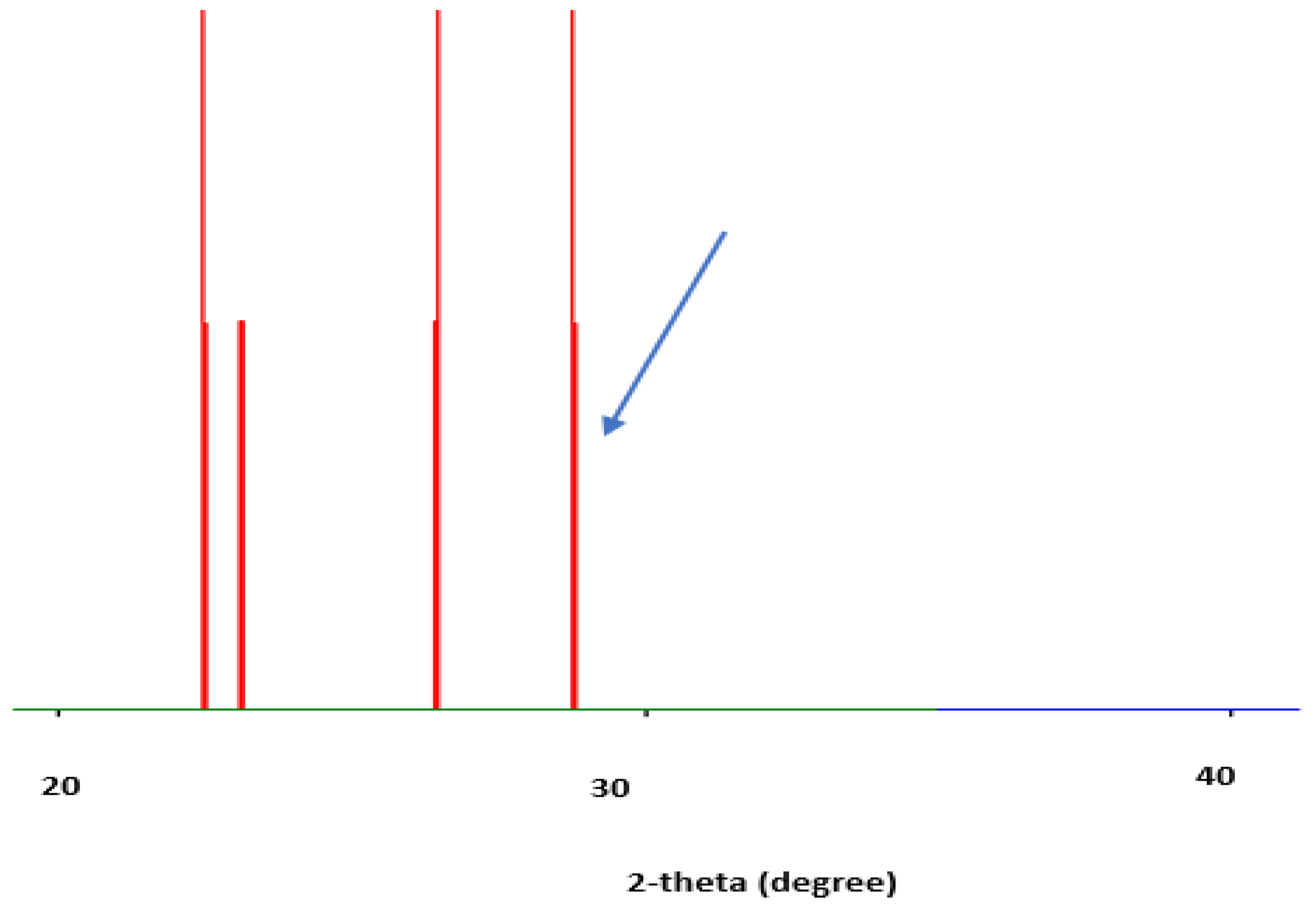
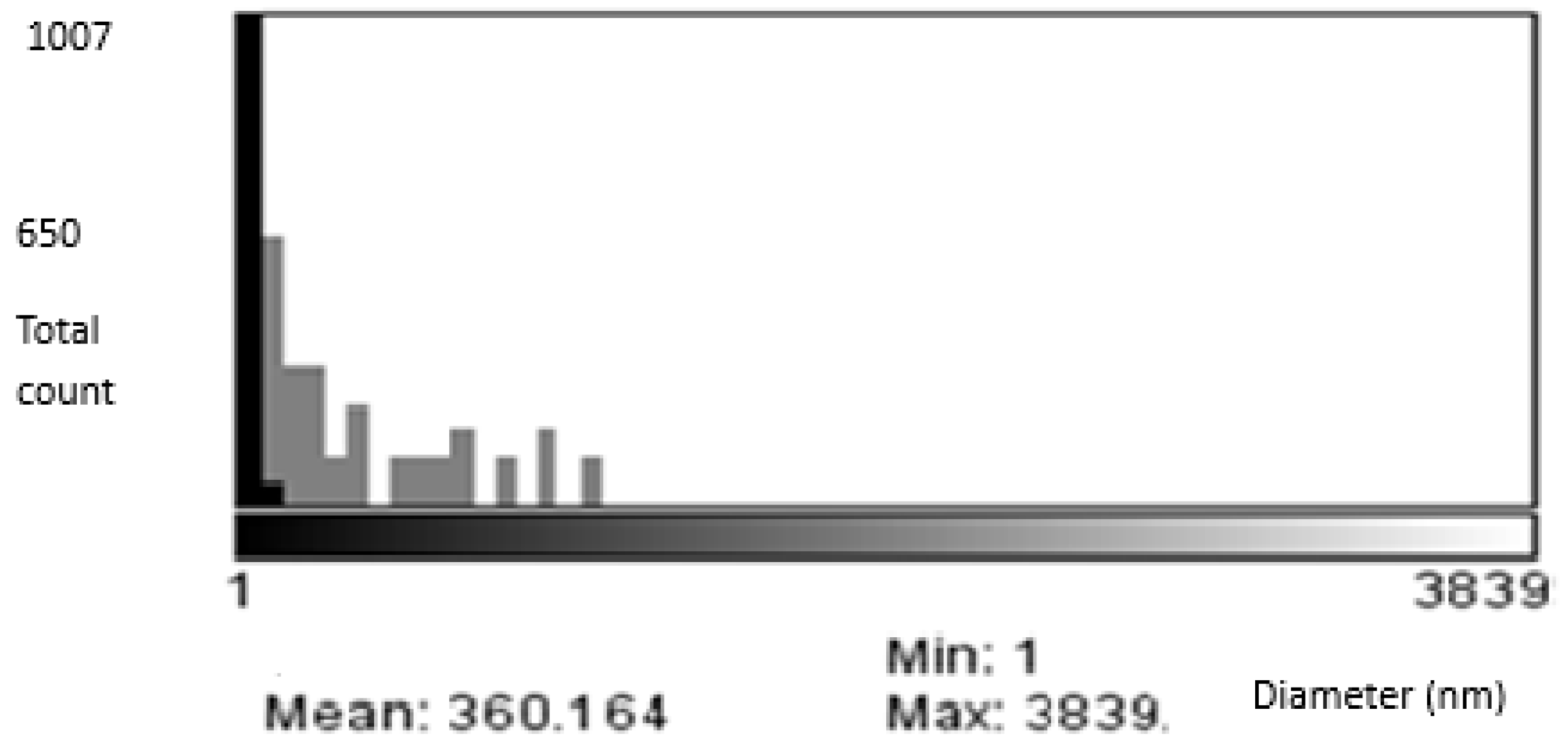
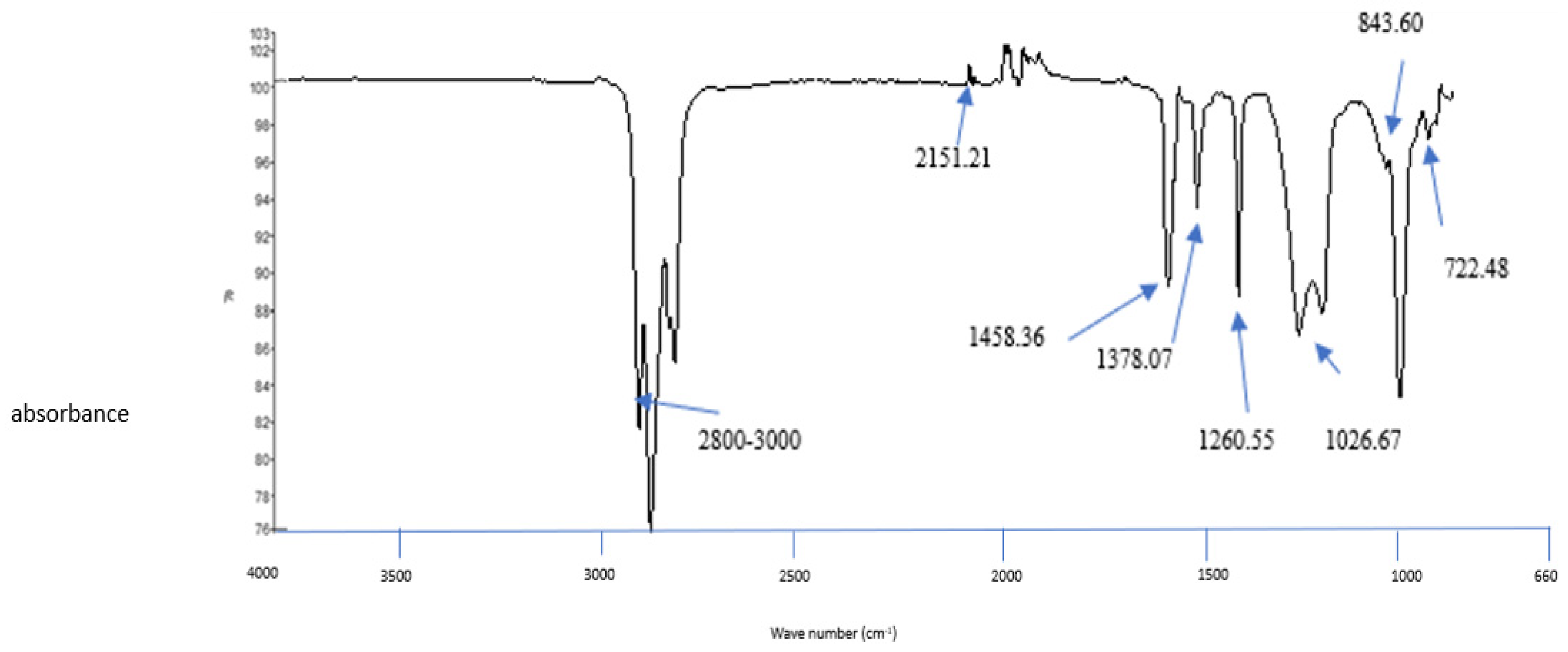
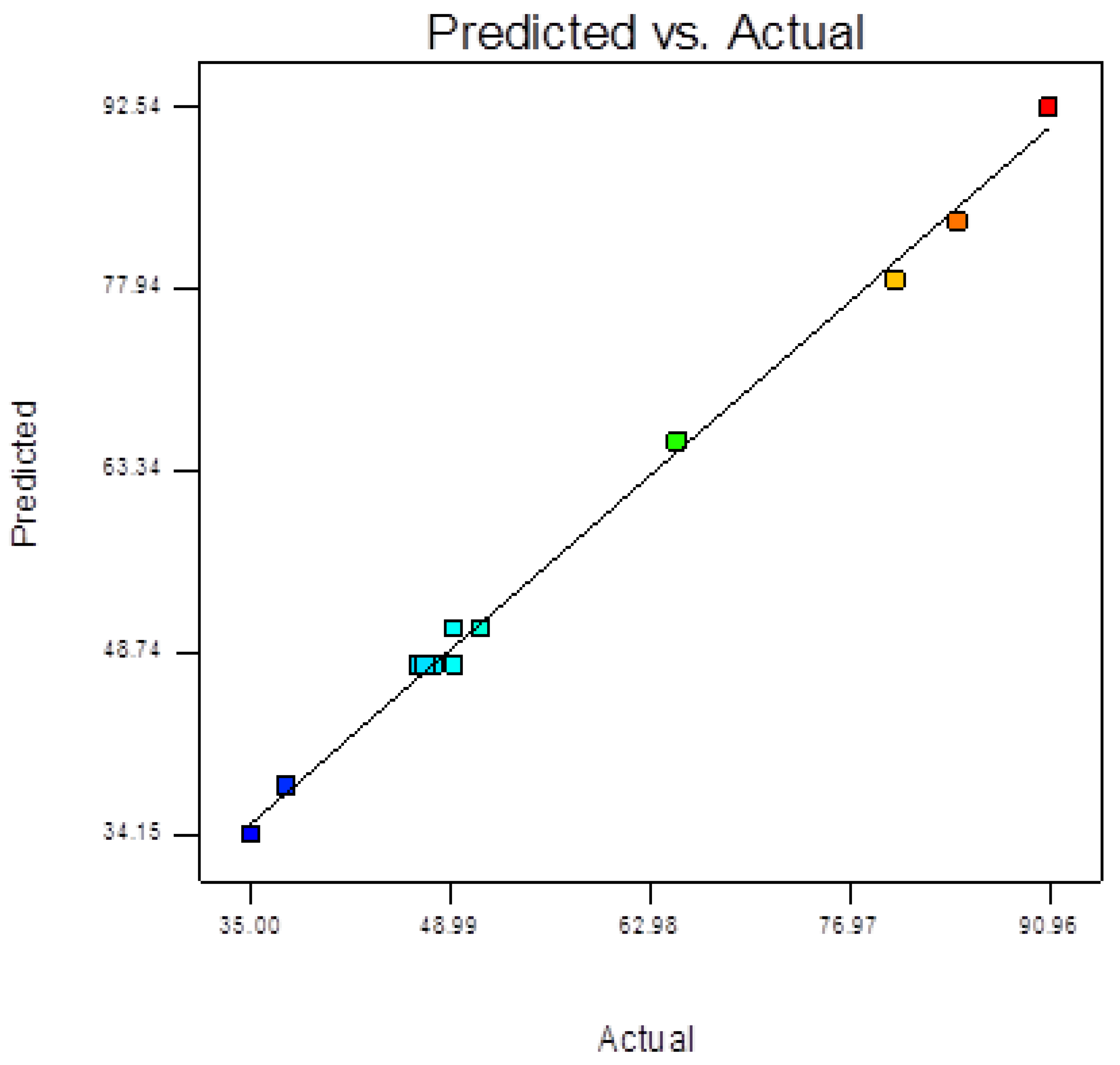
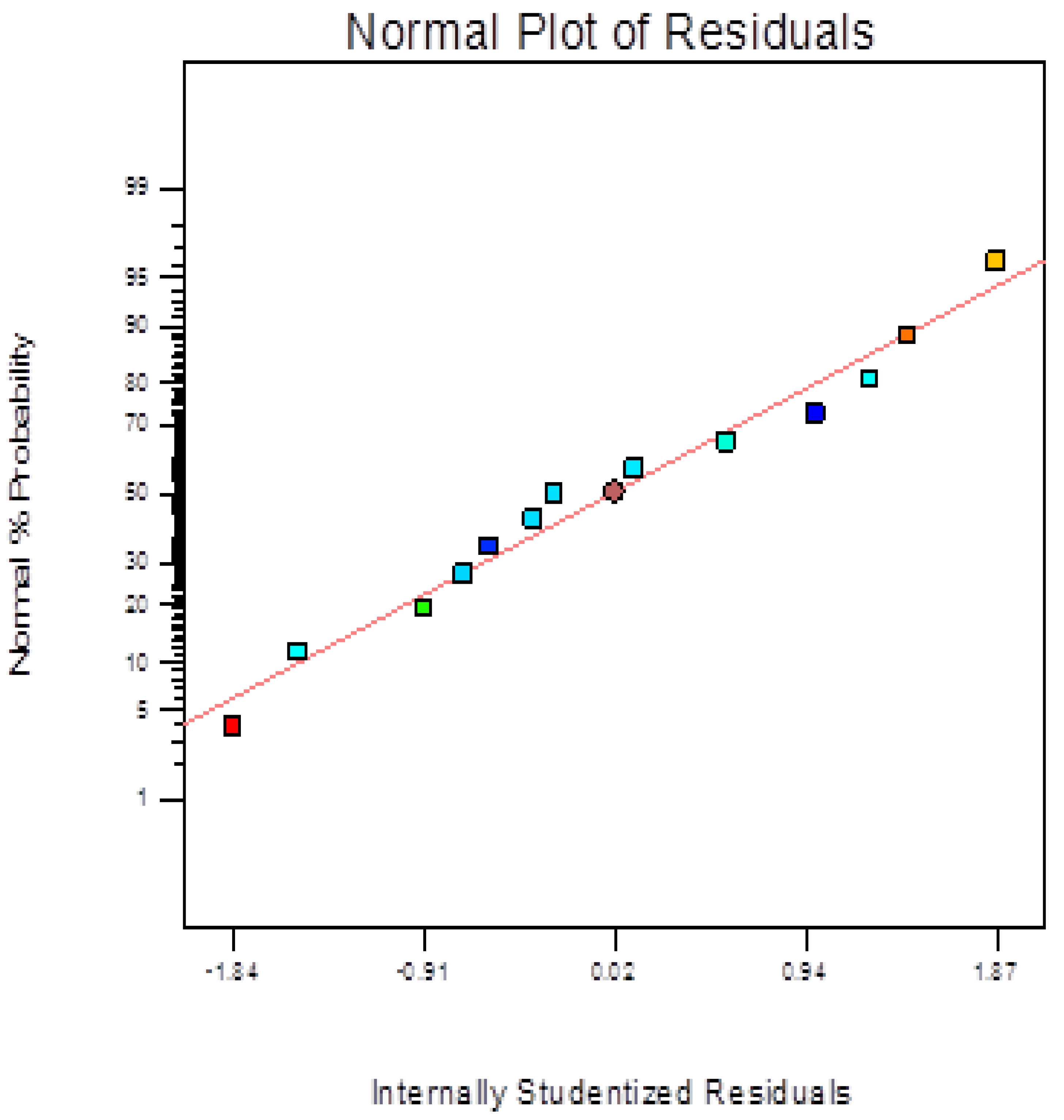
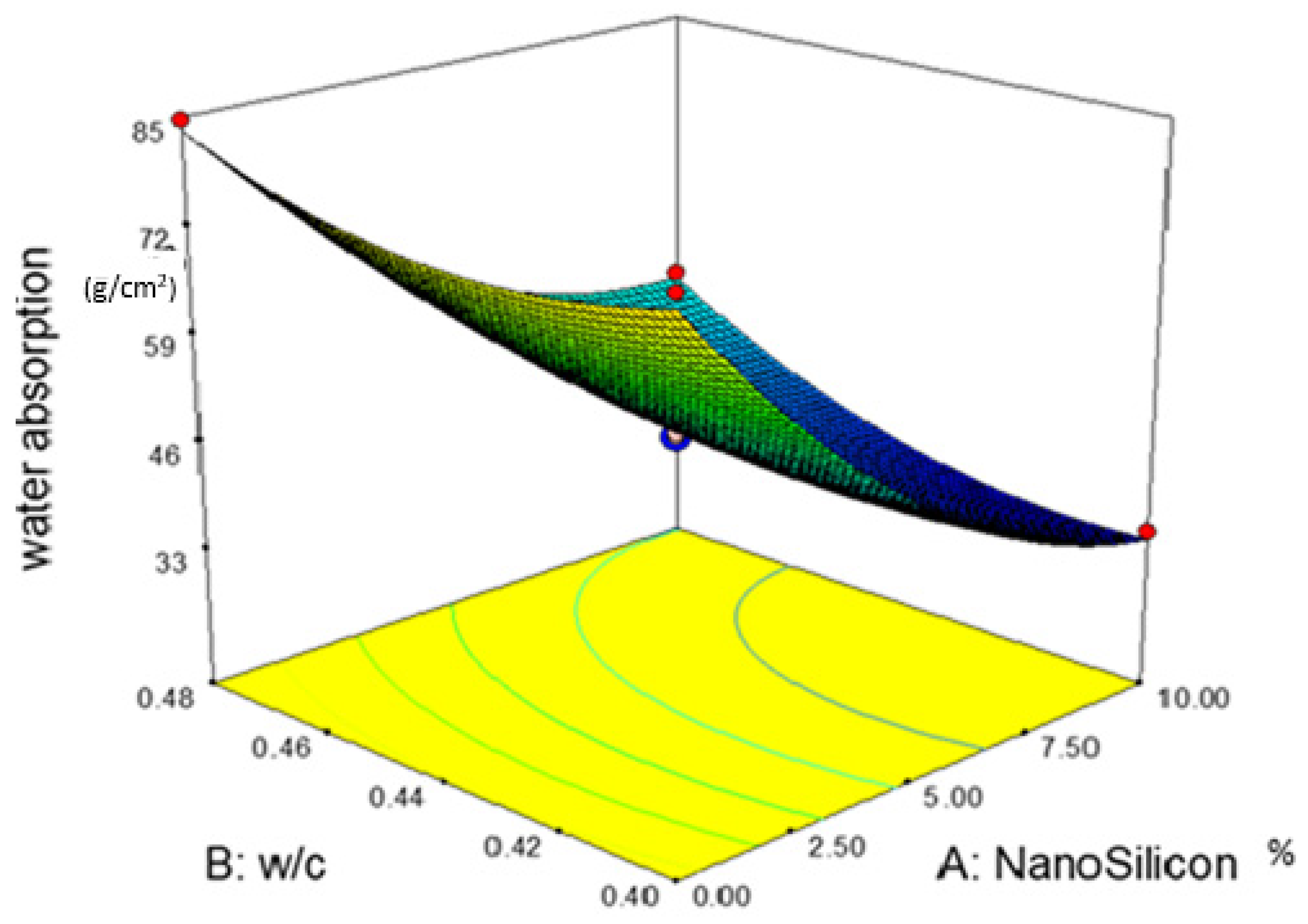

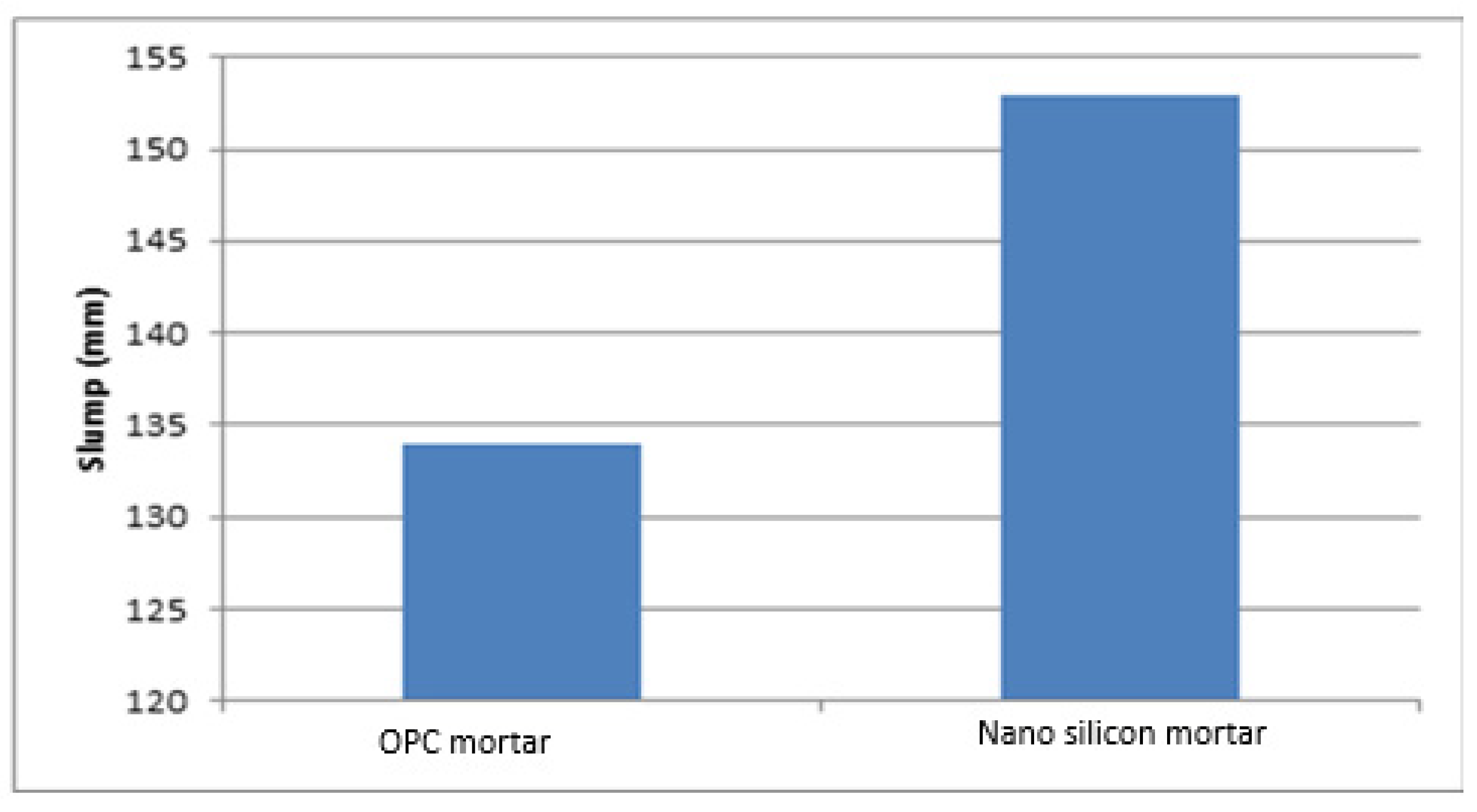



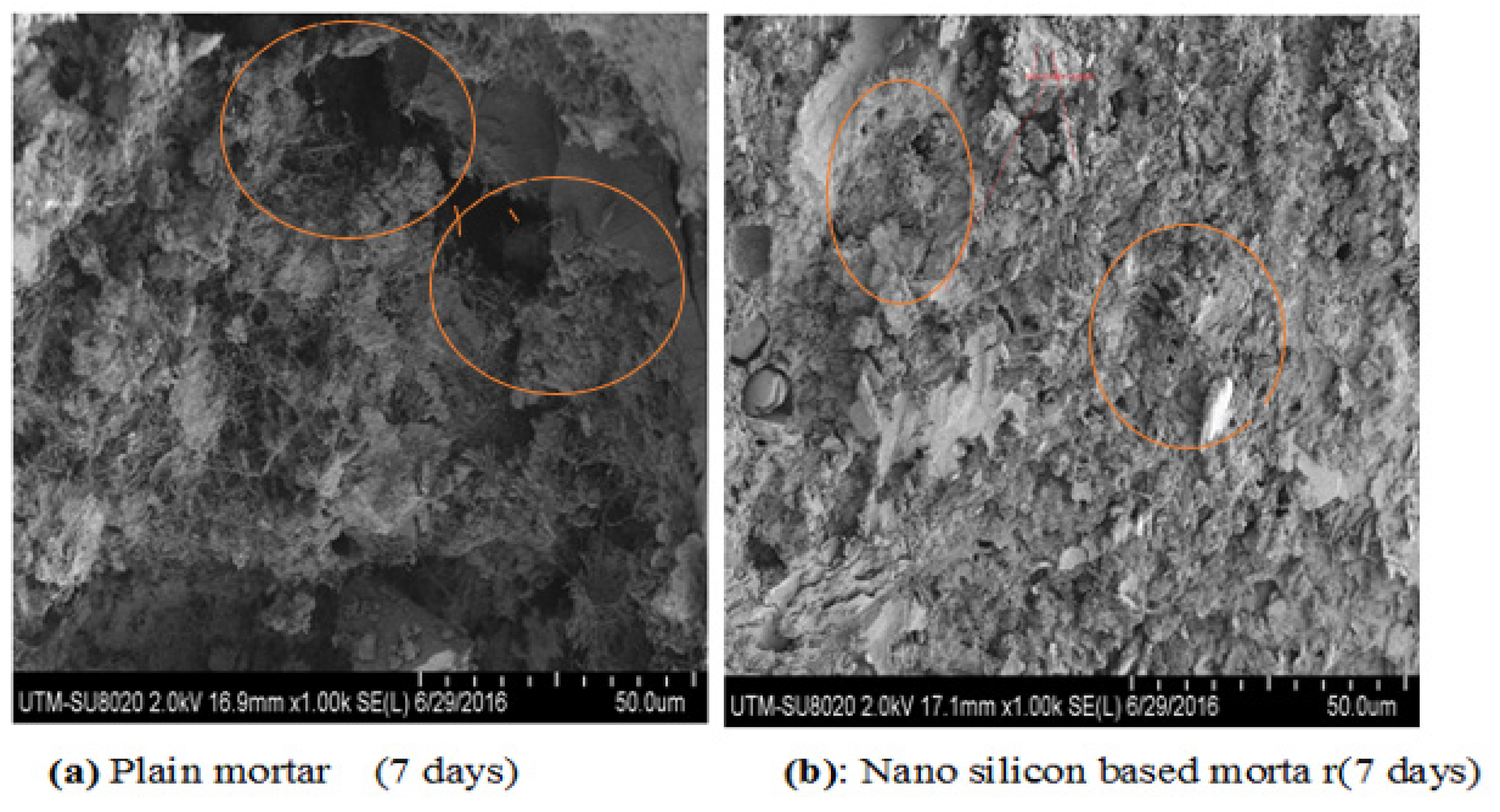
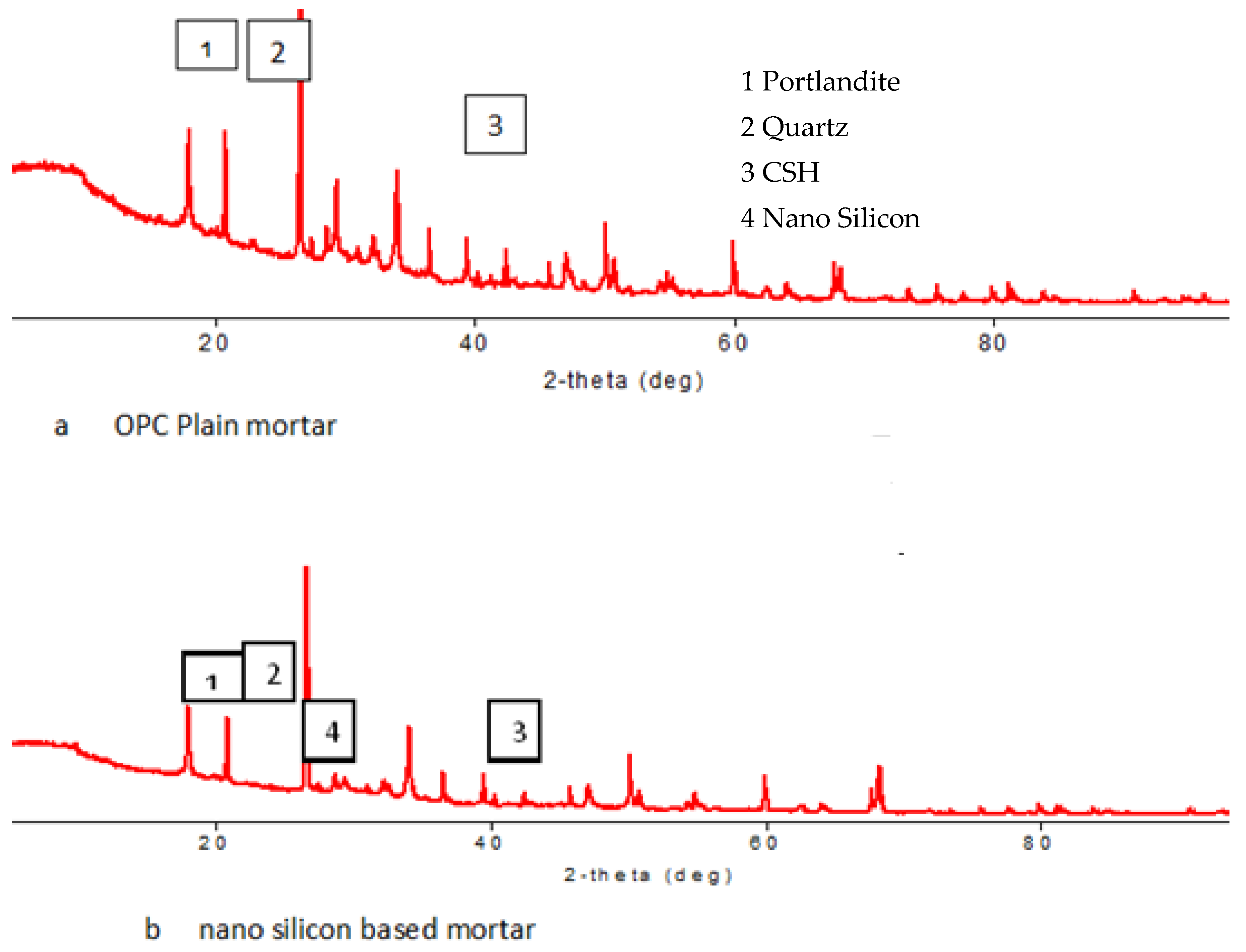
| Experimental Variables | Symbol | Level | ||
|---|---|---|---|---|
| Low (−1) | Centre Point (0) | High (1) | ||
| Nano Silicon (%) | A | 0 | 6.035 | 12.07 |
| w/c | B | 0.38 | 0.44 | 0.5 |
| Run | Factor 1 A: Nano Silicon % by Weight of Cement | Factor 2 B: w/c |
|---|---|---|
| 1 | 5.00 | 0.50 |
| 2 | 5.00 | 0.44 |
| 3 | 10.00 | 0.40 |
| 4 | 5.00 | 0.44 |
| 5 | 0.00 | 0.48 |
| 6 | 12.07 | 0.44 |
| 7 | 5.00 | 0.38 |
| 8 | 10.00 | 0.48 |
| 9 | 5.00 | 0.44 |
| 10 | 5.00 | 0.44 |
| 11 | 0.00 | 0.40 |
| 12 | 0.00 | 0.44 |
| 13 | 5.00 | 0.44 |
| Sample | Zeta Potential mV |
|---|---|
| OPC Mortar | +0.744 |
| Nano silicon | −0.0718 |
| Experiments Run | Variable 1 A: Nano Silicon % | Variable 2 B: w/c | Experimental Response Capillary Water Absorption (g/cm2) |
|---|---|---|---|
| 1 | 5.00 | 0.50 | 64.90 |
| 2 | 5.00 | 0.44 | 46.83 |
| 3 | 10.00 | 0.40 | 35.00 |
| 4 | 5.00 | 0.44 | 47.87 |
| 5 | 0.00 | 0.48 | 84.60 |
| 6 | 12.07 | 0.44 | 37.5 |
| 7 | 5.00 | 0.38 | 49.30 |
| 8 | 10.00 | 0.48 | 51.2 |
| 9 | 5.00 | 0.44 | 47.38 |
| 10 | 5.00 | 0.44 | 49.31 |
| 11 | 0.00 | 0.40 | 80.23 |
| 12 | 0.00 | 0.44 | 90.96 |
| 13 | 5.00 | 0.44 | 47.26 |
| Model Type | Sd | R2 | Adj R2 | Pred R2 | Press |
|---|---|---|---|---|---|
| Linear | 8.37 | 0.8203 | 0.7843 | 0.7024 | 1161.37 |
| Quadraitic | 1.41 | 0.9965 | 0.9939 | 0.9800 | 78.11 |
| Variation Sources | Sum of Squares | Degree of Freedom | Mean Square | F Value | p Value Prob > F | |
|---|---|---|---|---|---|---|
| Model | 3888.07 | 5 | 777.61 | 393.26 | 0.0001 | Significant |
| A | 2973.51 | 1 | 2973.51 | 1503.79 | 0.0001 | Significant |
| B | 227.18 | 1 | 227.18 | 114.89 | 0.0001 | Significant |
| AB | 34.99 | 1 | 34.99 | 17.69 | 0.004 | Significant |
| A2 | 535.49 | 1 | 535.49 | 270.81 | 0.0001 | Significant |
| B2 | 188.73 | 1 | 188.73 | 95.45 | 0.0001 | Significant |
| Residual | 13.84 | 7 | 1.98 | |||
| Lack of fit | 10.18 | 3 | 3.39 | 3.71 | 0.1190 | Not Significant |
| Pure Error | 3.66 | 4 | 0.92 | |||
| Cor Total | 3901.91 | 12 | ||||
| St dv | 1.41 | R2 | 0.9965 | |||
| Mean | 56.33 | AdjR2 | 0.9939, | |||
| C.V% | 2.50 | PreR2 | 0.9800 | |||
| Press | 78.11 | Adeq Precision | 61.127 |
| Run | A: Nanosilicon (%) | B: w/c | Predicted Water Absorption (g/cm2) | Actual Water Absorption (g/cm2) | Residual | Error (%) |
|---|---|---|---|---|---|---|
| 1 | 0.00 | 0.40 | 78.62 | 80.23 | 1.61 | 2.01 |
| 2 | 10.00 | 0.40 | 34.15 | 35.00 | 0.85 | 2.43 |
| 3 | 0.00 | 0.48 | 83.36 | 84.60 | 1.24 | 1.47 |
| 4 | 10 | 0.48 | 50.72 | 51.2 | 0.48 | 0.94 |
| 5 | 0.00 | 0.44 | 92.54 | 90.96 | 1.58 | 1.74 |
| 6 | 12.07 | 0.44 | 38.01 | 37.5 | 0.51 | 1.36 |
| 7 | 5.00 | 0.38 | 50.61 | 49.30 | 1.31 | 2.66 |
| 8 | 5.00 | 0.50 | 65.68 | 64.90 | 0.78 | 1.20 |
| 9 | 5.00 | 0.44 | 47.73 | 46.83 | 0.9 | 1.9 |
| 10 | 5.00 | 0.44 | 47.73 | 47.87 | 0.14 | 0.29 |
| 11 | 5.00 | 0.44 | 47.73 | 47.38 | 0.35 | 0.74 |
| 12 | 5.00 | 0.44 | 47.73 | 47.26 | 0.47 | 0.99 |
| 13 | 5.00 | 0.44 | 47.73 | 49.31 | 1.58 | 3.20 |
Disclaimer/Publisher’s Note: The statements, opinions and data contained in all publications are solely those of the individual author(s) and contributor(s) and not of MDPI and/or the editor(s). MDPI and/or the editor(s) disclaim responsibility for any injury to people or property resulting from any ideas, methods, instructions or products referred to in the content. |
© 2025 by the authors. Licensee MDPI, Basel, Switzerland. This article is an open access article distributed under the terms and conditions of the Creative Commons Attribution (CC BY) license (https://creativecommons.org/licenses/by/4.0/).
Share and Cite
Muhammad, N.Z.; Abd Majid, M.Z.; Keyvanfar, A.; Shafaghat, A.; MCcaffer, R.; Mirza, J.; Aliyu, M.M.; Sariyyu, M. Experimental Investigation into Waterproofing Performance of Cement Mortar Incorporating Nano Silicon. Buildings 2025, 15, 2227. https://doi.org/10.3390/buildings15132227
Muhammad NZ, Abd Majid MZ, Keyvanfar A, Shafaghat A, MCcaffer R, Mirza J, Aliyu MM, Sariyyu M. Experimental Investigation into Waterproofing Performance of Cement Mortar Incorporating Nano Silicon. Buildings. 2025; 15(13):2227. https://doi.org/10.3390/buildings15132227
Chicago/Turabian StyleMuhammad, Nasiru Zakari, Muhd Zaimi Abd Majid, Ali Keyvanfar, Arezou Shafaghat, Ronald MCcaffer, Jahangir Mirza, Muhammad Magana Aliyu, and Mujittafa Sariyyu. 2025. "Experimental Investigation into Waterproofing Performance of Cement Mortar Incorporating Nano Silicon" Buildings 15, no. 13: 2227. https://doi.org/10.3390/buildings15132227
APA StyleMuhammad, N. Z., Abd Majid, M. Z., Keyvanfar, A., Shafaghat, A., MCcaffer, R., Mirza, J., Aliyu, M. M., & Sariyyu, M. (2025). Experimental Investigation into Waterproofing Performance of Cement Mortar Incorporating Nano Silicon. Buildings, 15(13), 2227. https://doi.org/10.3390/buildings15132227









